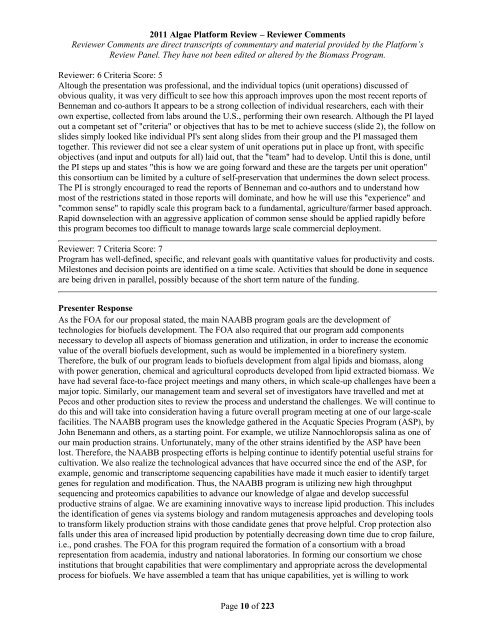Reviewer Comments - EERE
Reviewer Comments - EERE
Reviewer Comments - EERE
Create successful ePaper yourself
Turn your PDF publications into a flip-book with our unique Google optimized e-Paper software.
2011 Algae Platform Review – <strong>Reviewer</strong> <strong>Comments</strong><br />
<strong>Reviewer</strong> <strong>Comments</strong> are direct transcripts of commentary and material provided by the Platform’s<br />
Review Panel. They have not been edited or altered by the Biomass Program.<br />
<strong>Reviewer</strong>: 6 Criteria Score: 5<br />
Altough the presentation was professional, and the individual topics (unit operations) discussed of<br />
obvious quality, it was very difficult to see how this approach improves upon the most recent reports of<br />
Benneman and co-authors It appears to be a strong collection of individual researchers, each with their<br />
own expertise, collected from labs around the U.S., performing their own research. Although the PI layed<br />
out a competant set of "criteria" or objectives that has to be met to achieve success (slide 2), the follow on<br />
slides simply looked like individual PI's sent along slides from their group and the PI massaged them<br />
together. This reviewer did not see a clear system of unit operations put in place up front, with specific<br />
objectives (and input and outputs for all) laid out, that the "team" had to develop. Until this is done, until<br />
the PI steps up and states "this is how we are going forward and these are the targets per unit operation"<br />
this consortium can be limited by a culture of self-preservation that undermines the down select process.<br />
The PI is strongly encouraged to read the reports of Benneman and co-authors and to understand how<br />
most of the restrictions stated in those reports will dominate, and how he will use this "experience" and<br />
"common sense" to rapidly scale this program back to a fundamental, agriculture/farmer based approach.<br />
Rapid downselection with an aggressive application of common sense should be applied rapidly before<br />
this program becomes too difficult to manage towards large scale commercial deployment.<br />
<strong>Reviewer</strong>: 7 Criteria Score: 7<br />
Program has well-defined, specific, and relevant goals with quantitative values for productivity and costs.<br />
Milestones and decision points are identified on a time scale. Activities that should be done in sequence<br />
are being driven in parallel, possibly because of the short term nature of the funding.<br />
Presenter Response<br />
As the FOA for our proposal stated, the main NAABB program goals are the development of<br />
technologies for biofuels development. The FOA also required that our program add components<br />
necessary to develop all aspects of biomass generation and utilization, in order to increase the economic<br />
value of the overall biofuels development, such as would be implemented in a biorefinery system.<br />
Therefore, the bulk of our program leads to biofuels development from algal lipids and biomass, along<br />
with power generation, chemical and agricultural coproducts developed from lipid extracted biomass. We<br />
have had several face-to-face project meetings and many others, in which scale-up challenges have been a<br />
major topic. Similarly, our management team and several set of investigators have travelled and met at<br />
Pecos and other production sites to review the process and understand the challenges. We will continue to<br />
do this and will take into consideration having a future overall program meeting at one of our large-scale<br />
facilities. The NAABB program uses the knowledge gathered in the Acquatic Species Program (ASP), by<br />
John Benemann and others, as a starting point. For example, we utilize Nannochloropsis salina as one of<br />
our main production strains. Unfortunately, many of the other strains identified by the ASP have been<br />
lost. Therefore, the NAABB prospecting efforts is helping continue to identify potential useful strains for<br />
cultivation. We also realize the technological advances that have occurred since the end of the ASP, for<br />
example, genomic and transcriptome sequencing capabilities have made it much easier to identify target<br />
genes for regulation and modification. Thus, the NAABB program is utilizing new high throughput<br />
sequencing and proteomics capabilities to advance our knowledge of algae and develop successful<br />
productive strains of algae. We are examining innovative ways to increase lipid production. This includes<br />
the identification of genes via systems biology and random mutagenesis approaches and developing tools<br />
to transform likely production strains with those candidate genes that prove helpful. Crop protection also<br />
falls under this area of increased lipid production by potentially decreasing down time due to crop failure,<br />
i.e., pond crashes. The FOA for this program required the formation of a consortium with a broad<br />
representation from academia, industry and national laboratories. In forming our consortium we chose<br />
institutions that brought capabilities that were complimentary and appropriate across the developmental<br />
process for biofuels. We have assembled a team that has unique capabilities, yet is willing to work<br />
Page 10 of 223




